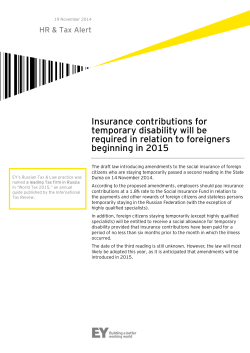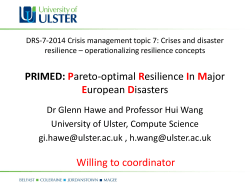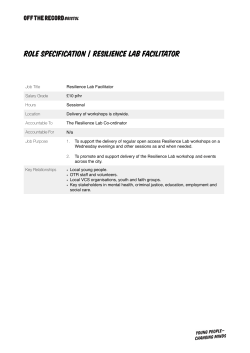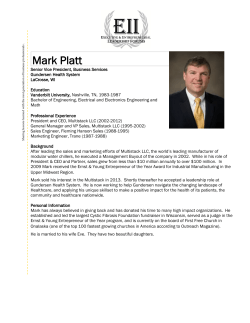
Business Resilience
Key contacts EY | Assurance | Tax | Transactions | Advisory Jon Morris + 44 20 7951 9869 jmorris10@uk.ey.com Amanda Blackhall O’Sullivan + 44 20 7951 7847 ablackhallosullivan@uk.ey.com Richard Harrison +44 20 7951 7295 rharrison@uk.ey.com Phil Dunne +44 20 7951 7628 pdunne@uk.ey.com About EY EY is a global leader in assurance, tax, transaction and advisory services. The insights and quality services we deliver help build trust and confidence in the capital markets and in economies the world over. We develop outstanding leaders who team to deliver on our promises to all of our stakeholders. In so doing, we play a critical role in building a better working world for our people, for our clients and for our communities. EY refers to the global organization, and may refer to one or more, of the member firms of Ernst & Young Global Limited, each of which is a separate legal entity. Ernst & Young Global Limited, a UK company limited by guarantee, does not provide services to clients. For more information about our organization, please visit ey.com. Ernst & Young LLP The UK firm Ernst & Young LLP is a limited liability partnership registered in England and Wales with registered number OC300001 and is a member firm of Ernst & Young Global Limited. Ernst & Young LLP, 1 More London Place, London, SE1 2AF. © 2015 Ernst & Young LLP. Published in the UK. All Rights Reserved. ED None Gary Turner +44 20 795 13311 gturner@uk.ey.com Chris Lowe +44 20 7951 0826 clowe@uk.ey.com 1592526.indd (UK) 01/15. Artwork by Creative Services Group Design. In line with EY’s commitment to minimise its impact on the environment, this document has been printed on paper with a high recycled content. Information in this publication is intended to provide only a general outline of the subjects covered. It should neither be regarded as comprehensive nor sufficient for making decisions, nor should it be used in place of professional advice. Ernst & Young LLP accepts no responsibility for any loss arising from any action taken or not taken by anyone using this material. ey.com/uk Andrew Wollaston +44 20 7951 9944 awollaston@uk.ey.com Tom Jack +44 161 333 2635 tjack1@uk.ey.com For related enquiries contact: businessresilience@uk.ey.com Business Resilience Actively adapting to preserve value 5 Economic uncertainty Regulatory scrutiny Technological innovation Aggressive capital Market uncertainty ► Impact of increasing regulation and intervention from regulators and governments ► Rapidly changing landscape of winners and losers driven by disruptive technology, changing consumer behaviours and habits and globalisation ► Shareholder activism is on the rise in Europe, with over $100bn of capital to invest ► Innovation and new market entrants impacting existing business models ► Traditional and alternative capital providers have huge amounts of capital ready to invest in high yield opportunities ► Customer trends and behaviours continue to drive rapid market transformations ► Economic uncertainty and geopolitical risk in a number of markets ► Political uncertainty and fiscal austerity constraining growth across Europe ► Volatile commodity prices and exchange rates creating a challenging business environment ► Revised 2014 Corporate Governance Code requiring companies to form a robust assessment of the risks threatening their business model over an extended period ► A connected economy with multiple information channels means business situations spread quickly and information is difficult to contain ► Capital is targeting undervalued businesses and capital inefficiency, including excess fixed assets and working capital ► A clear vision for the business, supported by market trends and organisational capabilities ► Operational risks, e.g., key supplier, input prices, IT and disruptive innovation are understood and managed ► Absence of clear strategy or significant changes in existing strategy ► Profit warnings and earnings underperformance versus peers ► Market concerns on credibility of corporate strategy ► Operating cash flow negative or poor cash conversion ► Credible management r lde ho nce e ► Active engagement and alignment with equity, financial and other stakeholders Market resilience ► Revenue risks, e.g., customer, product, market, competition and pricing are understood and managed ► Market and trading data regularly used to align customer facing activity ► Clear strategy regarding disruptive technologies Op e res ra ili Business resilience en ke t ce it en al ce 4 Operations tify en Id 3 Stakeholders l na tio ce en 2 Operational resilience r Ma li i res 1 What are the warning signs? Stakeholder resilience Sta k res e ili The 5 big issues Active management is critical to adapt in a changing environment Adapt There has never been a greater need for a company to assess its own business resilience p Ca ili e r s g M iti a te ► Stakeholders disunited ► Commodity or other input price risk ► Sudden or unexplained departure of CEO or CFO ► Over-dependence on key supplier or technology ► Operational capabilities built to deliver business vision, with safeguards against challenges to the operational footprint ► Threat or emergence of shareholder activism ► IT is not effectively integrated and fails to support the business Capital resilience Markets Capital ► Flexible long term financing and achievable debt covenants supported by robust cash forecasts ► Loss of market share, revenue deteriorating or growth rate behind peers ► Risk of, or actual, covenant breach or missed interest payment ► Over-dependence on major market or customer ► Refinancing required within 24 months ► Flexibility in the cost base to be able to react rapidly to change ► Strong working capital performance — building cash balances and capital efficiency ► Robust management of legacy liabilities ► Failed IPO or exit ► Market price pressure ► Excess or deficient working capital ► Inability to pass on input price changes ► Core lenders selling debt or debt trading at discount ► Disruptive technologies, new market entrants or competitor behaviour ► Lack of forward visibility re cash or cash targets ► Regulatory change Business resilience ► Cumbersome organisational structure ► Return on capital employed indicates excess capital
© Copyright 2025
















